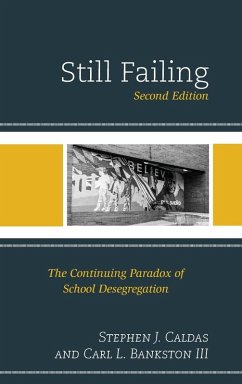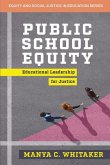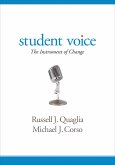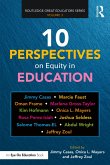- Gebundenes Buch
- Merkliste
- Auf die Merkliste
- Bewerten Bewerten
- Teilen
- Produkt teilen
- Produkterinnerung
- Produkterinnerung
This book includes an analysis of the most significant Supreme Court cases that have been decided in the ten years since the first edition of the book appeared. The authors consider the important implications of these recent rulings for the future of school desegregation in Americaâ s schools.
Andere Kunden interessierten sich auch für
![Failing Our Future Failing Our Future]() Joshua R. Eyler (University of Mississippi)Failing Our Future35,99 €
Joshua R. Eyler (University of Mississippi)Failing Our Future35,99 €![Public School Equity Public School Equity]() Manya Whitaker (USA Colorado College)Public School Equity33,99 €
Manya Whitaker (USA Colorado College)Public School Equity33,99 €![Breaking the Promise of Brown Breaking the Promise of Brown]() Stephen BreyerBreaking the Promise of Brown20,99 €
Stephen BreyerBreaking the Promise of Brown20,99 €![Witnessing Whiteness Witnessing Whiteness]() Shelly TochlukWitnessing Whiteness32,99 €
Shelly TochlukWitnessing Whiteness32,99 €![Witnessing Whiteness Witnessing Whiteness]() Shelly TochlukWitnessing Whiteness89,99 €
Shelly TochlukWitnessing Whiteness89,99 €![Student Voice Student Voice]() Russell J. QuagliaStudent Voice46,99 €
Russell J. QuagliaStudent Voice46,99 €![10 Perspectives on Equity in Education 10 Perspectives on Equity in Education]() 10 Perspectives on Equity in Education32,99 €
10 Perspectives on Equity in Education32,99 €-
-
-
This book includes an analysis of the most significant Supreme Court cases that have been decided in the ten years since the first edition of the book appeared. The authors consider the important implications of these recent rulings for the future of school desegregation in Americaâ s schools.
Produktdetails
- Produktdetails
- Verlag: Rowman & Littlefield
- Second Edition
- Seitenzahl: 186
- Erscheinungstermin: 24. Dezember 2014
- Englisch
- Abmessung: 229mm x 155mm x 20mm
- Gewicht: 444g
- ISBN-13: 9781610489621
- ISBN-10: 1610489624
- Artikelnr.: 41455158
- Herstellerkennzeichnung
- Libri GmbH
- Europaallee 1
- 36244 Bad Hersfeld
- gpsr@libri.de
- Verlag: Rowman & Littlefield
- Second Edition
- Seitenzahl: 186
- Erscheinungstermin: 24. Dezember 2014
- Englisch
- Abmessung: 229mm x 155mm x 20mm
- Gewicht: 444g
- ISBN-13: 9781610489621
- ISBN-10: 1610489624
- Artikelnr.: 41455158
- Herstellerkennzeichnung
- Libri GmbH
- Europaallee 1
- 36244 Bad Hersfeld
- gpsr@libri.de
Stephen J. Caldas has published many articles and books on school desegregation. He also publishes in the area of bilingual education. He currently teaches quantitative research methodology and education policy at Manhattanville College in New York.
Contents
Chapter 1 - School Desegregation: Irrelevant Public Policy?
The Continuing Racial and Socioeconomic Segregation of American Schools
Resegregation by the Numbers
Failure of Will or Failure of Command and Control?
Redistributing Children's "Social Capital"
The Fallacy of "Diversity"
Unintended Consequences
A Noble, Misguided Vision
Blinders of Moral Commitment
Chapter 2 - How Did We Get Here?
The Long Legal Road
The Genesis of Civil Rights
The Paradox of Slavery in Free Market Society
Reconstruction and the Origins of "Affirmative" Protection of Group Rights
Retreat from Reconstruction and the Protection of Group Rights
Plessy v. Ferguson and "Separate but Equal"
The Era of Jim Crow and American "Apartheid"
Black Grass Roots Resistance to "Separate but Equal"
The Earthquake of Brown I
Grass Roots Civil Rights Struggle
A Return to Reconstruction
The Desegregation Battle Intensifies
A Sea Change of Civil Rights
Freedom of Choice
"Affirmative" Action
Maximum Federal Involvement
Chapter 3-Desegregation Expansion-and Limits
Setting Limits
Unitary Status and the End of Oversight
The Diversity Doctrine and Supreme Court Schizophrenia
The Future of Desegregation Litigation
Chapter 4 - The Demographic Transformation of America
A Changing Society
Family Structure
Demographic Change: New Student Populations
Hispanic Explosion
The Asian Advantage
The Problem of Poverty
Demographics and School Desegregation
Chapter 5 - It takes "a certain" Kind of Village to Raise a Child
What is Social Capital?
Families, Schools and Communities: Social Capital and School Environments
Social Capital in Child and Parent Interactions
Social Capital in Parent-to-Parent Interactions
Social Capital in Parent and School Interactions
Social Capital in Student-to-Student Interactions
The Power of School Peer Cultures
Chapter 6 - The Power of School Peers and the Power of Community
The Positive Power of Peers
Disruptive School Climates
Schools and the Creation of Community Social Capital
Desegregation and the Destruction of Community Social Capital
Understanding the Importance of Community
Chapter 7 - School Desegregation and the Racial Achievement Gap
A Controversial Topic
Is There Really a Gap?
The SAT/ACT Gap
The High School Gap
The Higher Ed Gap
Why the Continuing Gap?
The Origins of the Black-White Gap
History of Racial Oppression as Cause of the Black/White Achievement Gap
Environmental Hazards and Educational Achievement
School Curriculum
Stereotype Threat
Why the Need for School Racial Integration?
Do Blacks Achieve Better in Majority White Schools?
Is White Achievement Hurt in Majority Black Schools?
Are Standardized Tests Culturally Biased Against Minorities?
The Stubborn Gap
How Can We Close the Gap?
Chapter 8 - A New Perspective of Race and Schooling: Attaining the Dream
New Paradigms
Resistance
Socioeconomic Integration
Strategies that Work
Neighborhood Schools
Strengthening Communities
Public Support for Public Education
Local Control in Minority Communities
Approach Reforms with Caution and Limited Expectations
Let Schools Be Schools
Chapter 1 - School Desegregation: Irrelevant Public Policy?
The Continuing Racial and Socioeconomic Segregation of American Schools
Resegregation by the Numbers
Failure of Will or Failure of Command and Control?
Redistributing Children's "Social Capital"
The Fallacy of "Diversity"
Unintended Consequences
A Noble, Misguided Vision
Blinders of Moral Commitment
Chapter 2 - How Did We Get Here?
The Long Legal Road
The Genesis of Civil Rights
The Paradox of Slavery in Free Market Society
Reconstruction and the Origins of "Affirmative" Protection of Group Rights
Retreat from Reconstruction and the Protection of Group Rights
Plessy v. Ferguson and "Separate but Equal"
The Era of Jim Crow and American "Apartheid"
Black Grass Roots Resistance to "Separate but Equal"
The Earthquake of Brown I
Grass Roots Civil Rights Struggle
A Return to Reconstruction
The Desegregation Battle Intensifies
A Sea Change of Civil Rights
Freedom of Choice
"Affirmative" Action
Maximum Federal Involvement
Chapter 3-Desegregation Expansion-and Limits
Setting Limits
Unitary Status and the End of Oversight
The Diversity Doctrine and Supreme Court Schizophrenia
The Future of Desegregation Litigation
Chapter 4 - The Demographic Transformation of America
A Changing Society
Family Structure
Demographic Change: New Student Populations
Hispanic Explosion
The Asian Advantage
The Problem of Poverty
Demographics and School Desegregation
Chapter 5 - It takes "a certain" Kind of Village to Raise a Child
What is Social Capital?
Families, Schools and Communities: Social Capital and School Environments
Social Capital in Child and Parent Interactions
Social Capital in Parent-to-Parent Interactions
Social Capital in Parent and School Interactions
Social Capital in Student-to-Student Interactions
The Power of School Peer Cultures
Chapter 6 - The Power of School Peers and the Power of Community
The Positive Power of Peers
Disruptive School Climates
Schools and the Creation of Community Social Capital
Desegregation and the Destruction of Community Social Capital
Understanding the Importance of Community
Chapter 7 - School Desegregation and the Racial Achievement Gap
A Controversial Topic
Is There Really a Gap?
The SAT/ACT Gap
The High School Gap
The Higher Ed Gap
Why the Continuing Gap?
The Origins of the Black-White Gap
History of Racial Oppression as Cause of the Black/White Achievement Gap
Environmental Hazards and Educational Achievement
School Curriculum
Stereotype Threat
Why the Need for School Racial Integration?
Do Blacks Achieve Better in Majority White Schools?
Is White Achievement Hurt in Majority Black Schools?
Are Standardized Tests Culturally Biased Against Minorities?
The Stubborn Gap
How Can We Close the Gap?
Chapter 8 - A New Perspective of Race and Schooling: Attaining the Dream
New Paradigms
Resistance
Socioeconomic Integration
Strategies that Work
Neighborhood Schools
Strengthening Communities
Public Support for Public Education
Local Control in Minority Communities
Approach Reforms with Caution and Limited Expectations
Let Schools Be Schools
Contents
Chapter 1 - School Desegregation: Irrelevant Public Policy?
The Continuing Racial and Socioeconomic Segregation of American Schools
Resegregation by the Numbers
Failure of Will or Failure of Command and Control?
Redistributing Children's "Social Capital"
The Fallacy of "Diversity"
Unintended Consequences
A Noble, Misguided Vision
Blinders of Moral Commitment
Chapter 2 - How Did We Get Here?
The Long Legal Road
The Genesis of Civil Rights
The Paradox of Slavery in Free Market Society
Reconstruction and the Origins of "Affirmative" Protection of Group Rights
Retreat from Reconstruction and the Protection of Group Rights
Plessy v. Ferguson and "Separate but Equal"
The Era of Jim Crow and American "Apartheid"
Black Grass Roots Resistance to "Separate but Equal"
The Earthquake of Brown I
Grass Roots Civil Rights Struggle
A Return to Reconstruction
The Desegregation Battle Intensifies
A Sea Change of Civil Rights
Freedom of Choice
"Affirmative" Action
Maximum Federal Involvement
Chapter 3-Desegregation Expansion-and Limits
Setting Limits
Unitary Status and the End of Oversight
The Diversity Doctrine and Supreme Court Schizophrenia
The Future of Desegregation Litigation
Chapter 4 - The Demographic Transformation of America
A Changing Society
Family Structure
Demographic Change: New Student Populations
Hispanic Explosion
The Asian Advantage
The Problem of Poverty
Demographics and School Desegregation
Chapter 5 - It takes "a certain" Kind of Village to Raise a Child
What is Social Capital?
Families, Schools and Communities: Social Capital and School Environments
Social Capital in Child and Parent Interactions
Social Capital in Parent-to-Parent Interactions
Social Capital in Parent and School Interactions
Social Capital in Student-to-Student Interactions
The Power of School Peer Cultures
Chapter 6 - The Power of School Peers and the Power of Community
The Positive Power of Peers
Disruptive School Climates
Schools and the Creation of Community Social Capital
Desegregation and the Destruction of Community Social Capital
Understanding the Importance of Community
Chapter 7 - School Desegregation and the Racial Achievement Gap
A Controversial Topic
Is There Really a Gap?
The SAT/ACT Gap
The High School Gap
The Higher Ed Gap
Why the Continuing Gap?
The Origins of the Black-White Gap
History of Racial Oppression as Cause of the Black/White Achievement Gap
Environmental Hazards and Educational Achievement
School Curriculum
Stereotype Threat
Why the Need for School Racial Integration?
Do Blacks Achieve Better in Majority White Schools?
Is White Achievement Hurt in Majority Black Schools?
Are Standardized Tests Culturally Biased Against Minorities?
The Stubborn Gap
How Can We Close the Gap?
Chapter 8 - A New Perspective of Race and Schooling: Attaining the Dream
New Paradigms
Resistance
Socioeconomic Integration
Strategies that Work
Neighborhood Schools
Strengthening Communities
Public Support for Public Education
Local Control in Minority Communities
Approach Reforms with Caution and Limited Expectations
Let Schools Be Schools
Chapter 1 - School Desegregation: Irrelevant Public Policy?
The Continuing Racial and Socioeconomic Segregation of American Schools
Resegregation by the Numbers
Failure of Will or Failure of Command and Control?
Redistributing Children's "Social Capital"
The Fallacy of "Diversity"
Unintended Consequences
A Noble, Misguided Vision
Blinders of Moral Commitment
Chapter 2 - How Did We Get Here?
The Long Legal Road
The Genesis of Civil Rights
The Paradox of Slavery in Free Market Society
Reconstruction and the Origins of "Affirmative" Protection of Group Rights
Retreat from Reconstruction and the Protection of Group Rights
Plessy v. Ferguson and "Separate but Equal"
The Era of Jim Crow and American "Apartheid"
Black Grass Roots Resistance to "Separate but Equal"
The Earthquake of Brown I
Grass Roots Civil Rights Struggle
A Return to Reconstruction
The Desegregation Battle Intensifies
A Sea Change of Civil Rights
Freedom of Choice
"Affirmative" Action
Maximum Federal Involvement
Chapter 3-Desegregation Expansion-and Limits
Setting Limits
Unitary Status and the End of Oversight
The Diversity Doctrine and Supreme Court Schizophrenia
The Future of Desegregation Litigation
Chapter 4 - The Demographic Transformation of America
A Changing Society
Family Structure
Demographic Change: New Student Populations
Hispanic Explosion
The Asian Advantage
The Problem of Poverty
Demographics and School Desegregation
Chapter 5 - It takes "a certain" Kind of Village to Raise a Child
What is Social Capital?
Families, Schools and Communities: Social Capital and School Environments
Social Capital in Child and Parent Interactions
Social Capital in Parent-to-Parent Interactions
Social Capital in Parent and School Interactions
Social Capital in Student-to-Student Interactions
The Power of School Peer Cultures
Chapter 6 - The Power of School Peers and the Power of Community
The Positive Power of Peers
Disruptive School Climates
Schools and the Creation of Community Social Capital
Desegregation and the Destruction of Community Social Capital
Understanding the Importance of Community
Chapter 7 - School Desegregation and the Racial Achievement Gap
A Controversial Topic
Is There Really a Gap?
The SAT/ACT Gap
The High School Gap
The Higher Ed Gap
Why the Continuing Gap?
The Origins of the Black-White Gap
History of Racial Oppression as Cause of the Black/White Achievement Gap
Environmental Hazards and Educational Achievement
School Curriculum
Stereotype Threat
Why the Need for School Racial Integration?
Do Blacks Achieve Better in Majority White Schools?
Is White Achievement Hurt in Majority Black Schools?
Are Standardized Tests Culturally Biased Against Minorities?
The Stubborn Gap
How Can We Close the Gap?
Chapter 8 - A New Perspective of Race and Schooling: Attaining the Dream
New Paradigms
Resistance
Socioeconomic Integration
Strategies that Work
Neighborhood Schools
Strengthening Communities
Public Support for Public Education
Local Control in Minority Communities
Approach Reforms with Caution and Limited Expectations
Let Schools Be Schools








